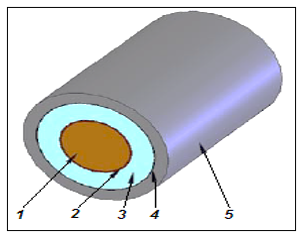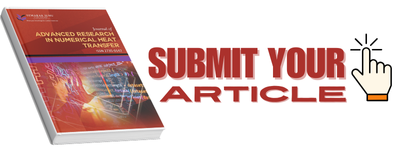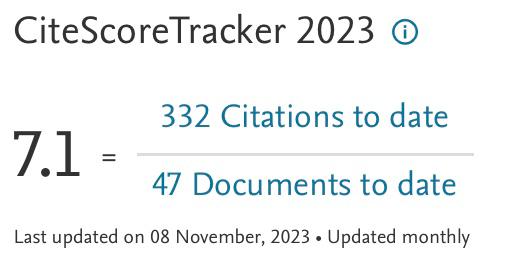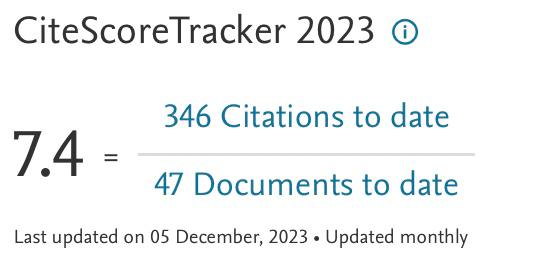Thermal State Effects on Potential Augmentation of the Ampacity of a Medium Voltage Underground Cable in Power Distribution: A Case Study
DOI:
https://doi.org/10.37934/arnht.18.1.113Keywords:
Underground cables, Ampacity, Thermal state, Power distribution networks, CHT modelingAbstract
This research aims at a deeper understanding of the steady-state thermal behavior of underground cables using Computational Heat Transfer (CHT) techniques modeling based Ansys Fluent software. The results concern the thermal study of 33 kV single and multiple copper conductors with a nominal conductor cross-section of 615 mm2 buried in the ground for a single cable, two cables and for three cables in horizontal position. The most unfavorable summer conditions, the burial depth as well as the physical properties of the soil as a function of the moisture content, are studied. The operating current of the conductors is taken 940 A. The results show that the temperature of the cables decreases with the burial depth, a compromise temperature/cost of installation corresponds to 80 cm of burial depth. Further, the maximum temperature of a single cable buried in the ground is considerably lower than that allowed (363 K) for a good use, namely 313 K in summer conditions, so there is a considerable margin to increase its ampacity, also the temperature decrease with increase of water content of the soil surrounding the cable of approximately 2 to 5 degrees. The results obtained are in good agreement with those of the literature.
Downloads
References
CIGRE, Statistics of AC underground cables in Power networks. Working Group B1.07. ISBN 978-2-85873-026-1 Technical Brochure Ref. No.: 338 CE/SC: B1, 2007. Paris-France.
Neher, J. H., and M. H. McGrath. "The calculation or the temperature rise and load capability of cable systems." RATIO 50, no. 2 (1994): 5.
Benato, Roberto, Luigi Colla, Sebastian Dambone Sessa, and Marco Marelli. "Review of high current rating insulated cable solutions." Electric Power Systems Research 133 (2016): 36-41. https://doi.org/10.1016/j.epsr.2015.12.005
Calculation of the Current Rating – Part 1-1: Current Rating Equations (100% Load Factor) and Calculation of Losses – General, IEC 60287-1, 2006.
Calculation of the Current Rating – Part 2-1: Thermal Resistance – Calculation of Thermal Resistance, IEC 60287-2, 2006.
Exizidis, Lazaros, François Vallée, Zacharie De Grève, Jacques Lobry, and Vasilis Chatziathanasiou. "Thermal behavior of power cables in offshore wind sites considering wind speed uncertainty." Applied Thermal Engineering 91 (2015): 471-478. https://doi.org/10.1016/j.applthermaleng.2015.08.037
Oh, Hyunjun, Jun Yao, James M. Tinjum, and William J. Likos. "Thermal resistivity dry-out curves for three sandy soils." In Geo-Congress 2014: Geo-characterization and Modeling for Sustainability, pp. 2795-2803. 2014. https://doi.org/10.1061/9780784413272.270
Ocùoñ, P., Dawid Taler, Piotr Cisek, and Marcin Pilarczyk. "Fem-based thermal analysis of underground power cables located in backfills made of different materials." Strength of Materials 47 (2015): 770-780. https://doi.org/10.1007/s11223-015-9713-4
Ocłoń, Paweł, Piotr Cisek, Marcin Pilarczyk, and Dawid Taler. "Numerical simulation of heat dissipation processes in underground power cable system situated in thermal backfill and buried in a multilayered soil." Energy Conversion and Management 95 (2015): 352-370. https://doi.org/10.1016/j.enconman.2015.01.092
Chatzipanagiotou, Panagiotis, Vasilis Chatziathanasiou, Gilbert De Mey, and Boguslaw Więcek. "Influence of soil humidity on the thermal impedance, time constant and structure function of underground cables: A laboratory experiment." Applied Thermal Engineering 113 (2017): 1444-1451. https://doi.org/10.1016/j.applthermaleng.2016.11.117
Al-Saud, M. S., M. A. El-Kady, and R. D. Findlay. "A new approach to underground cable performance assessment." Electric Power Systems Research 78, no. 5 (2008): 907-918. https://doi.org/10.1016/j.epsr.2007.06.010
Sellers, Sally M., and W. Z. Black. "Refinements to the Neher-McGrath model for calculating the ampacity of underground cables." Ieee transactions on power delivery 11, no. 1 (1996): 12-30. https://doi.org/10.1109/61.483997
de Lieto Vollaro, Roberto, Lucia Fontana, and Andrea Vallati. "Thermal analysis of underground electrical power cables buried in non-homogeneous soils." Applied Thermal Engineering 31, no. 5 (2011): 772-778https://doi.org/10.1016/j.applthermaleng.2010.10.024.
National Fire Protection Association, NFPA 70, National Electrical Code, 2017 ed., (2016) Quincy, MA, USA.
Ocłoń, Paweł, Piotr Cisek, Monika Rerak, Dawid Taler, R. Venkata Rao, Andrea Vallati, and Marcin Pilarczyk. "Thermal performance optimization of the underground power cable system by using a modified Jaya algorithm." International Journal of Thermal Sciences 123 (2018): 162-180. https://doi.org/10.1016/j.ijthermalsci.2017.09.015
Williams, G. M., P. L. Lewin, and M. LeBlanc. "Accurate determination of ambient temperature at burial depth for high voltage cable ratings." In Conference Record of the 2004 IEEE International Symposium on Electrical Insulation, pp. 458-461. IEEE, 2004.
Lindström, Ludvig. "Evaluating impact on ampacity according to IEC-60287 regarding thermally unfavourable placement of power cables." (2011).
Nahman, Jovan, and Miladin Tanaskovic. "Evaluation of the loading capacity of a pair of three-phase high voltage cable systems using the finite-element method." Electric power systems research 81, no. 7 (2011): 1550-1555. https://doi.org/10.1016/j.epsr.2011.03.005
Nahman, Jovan, and Miladin Tanaskovic. "Calculation of the ampacity of high voltage cables by accounting for radiation and solar heating effects using FEM." International Transactions on Electrical Energy Systems 23, no. 3 (2013): 301-314. https://doi.org/10.1002/etep.660
Dardan Klimenta, Bojan Perović, Jelena Klimenta, Milena Jevtić, Miloš Milovanović, Ivan Krstić. “Modelling the thermal effect of solar radiation on the ampacity of a low voltage underground cable.” International Journal of Thermal Sciences 134 (2018): 507-516. https://doi.org/10.1016/j.ijthermalsci.2018.08.012
Rerak, Monika, and Paweł Ocłoń. "Thermal analysis of underground power cable system." Journal of Thermal Science 26 (2017): 465-471. https://doi.org/10.1007/s11630-017-0963-2
Ocłoń, Paweł, Marco Bittelli, Piotr Cisek, Eva Kroener, Marcin Pilarczyk, Dawid Taler, Ravipudi Venkata Rao, and Andrea Vallati. "The performance analysis of a new thermal backfill material for underground power cable system." Applied Thermal Engineering 108 (2016): 233-250. https://doi.org/10.1016/j.applthermaleng.2016.07.102
Makhkamova, Irina. "Numerical investigations of the thermal state of overhead lines and underground cables in distribution networks." PhD diss., Durham University, 2011.
Salata, Ferdinando, Fabio Nardecchia, Franco Gugliermetti, and Andrea de Lieto Vollaro. "How thermal conductivity of excavation materials affects the behavior of underground power cables." Applied Thermal Engineering 100 (2016): 528-537. https://doi.org/10.1016/j.applthermaleng.2016.01.168
King, Sing-Yui, and Nicholas A. Halfter. "Underground power cables." (No Title) (1982).
P17 Part3. Current Rating for distribution cables: Ratings for 11kV and 33 kV cables having extruded insulation. 2004. Issue 1.
Energy Networks Association. Moore, G.F. (Editor), Electric Cables Handbook/ BICC Cables, 2004 Third Edition, Blackwell Science.
Moya, R. E. S., A. T. Prata, and JAB Cunha Neto. "Experimental analysis of unsteady heat and moisture transfer around a heated cylinder buried into a porous medium." International journal of heat and mass transfer 42, no. 12 (1999): 2187-2198. https://doi.org/10.1016/S0017-9310(98)00322-6
Millar, R. John, and Matti Lehtonen. "Real-time transient temperature computation of power cables including moisture migration modelling." The 15th PSCC, Liege, 22-26 August 2005, 8 pages. http://lib.tkk.fi/Diss/2006/isbn9512284162/
Dardan Klimenta, Bojan Perović, Jelena Klimenta, Milena Jevtić, Miloš Milovanović, Ivan Krstić. “Controlling the thermal environment of underground cable lines using the pavement surface radiation properties.” IET Gener. Transm. Distrib., 12 (12) (2018): 2968-2976 https://doi.org/10.1049/iet-gtd.2017.1298





























